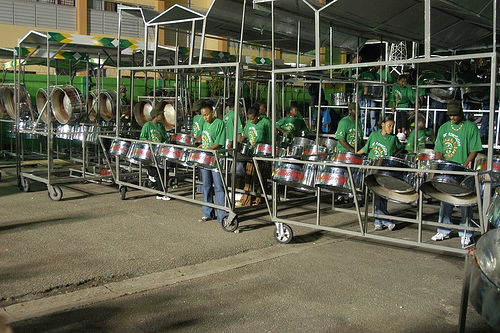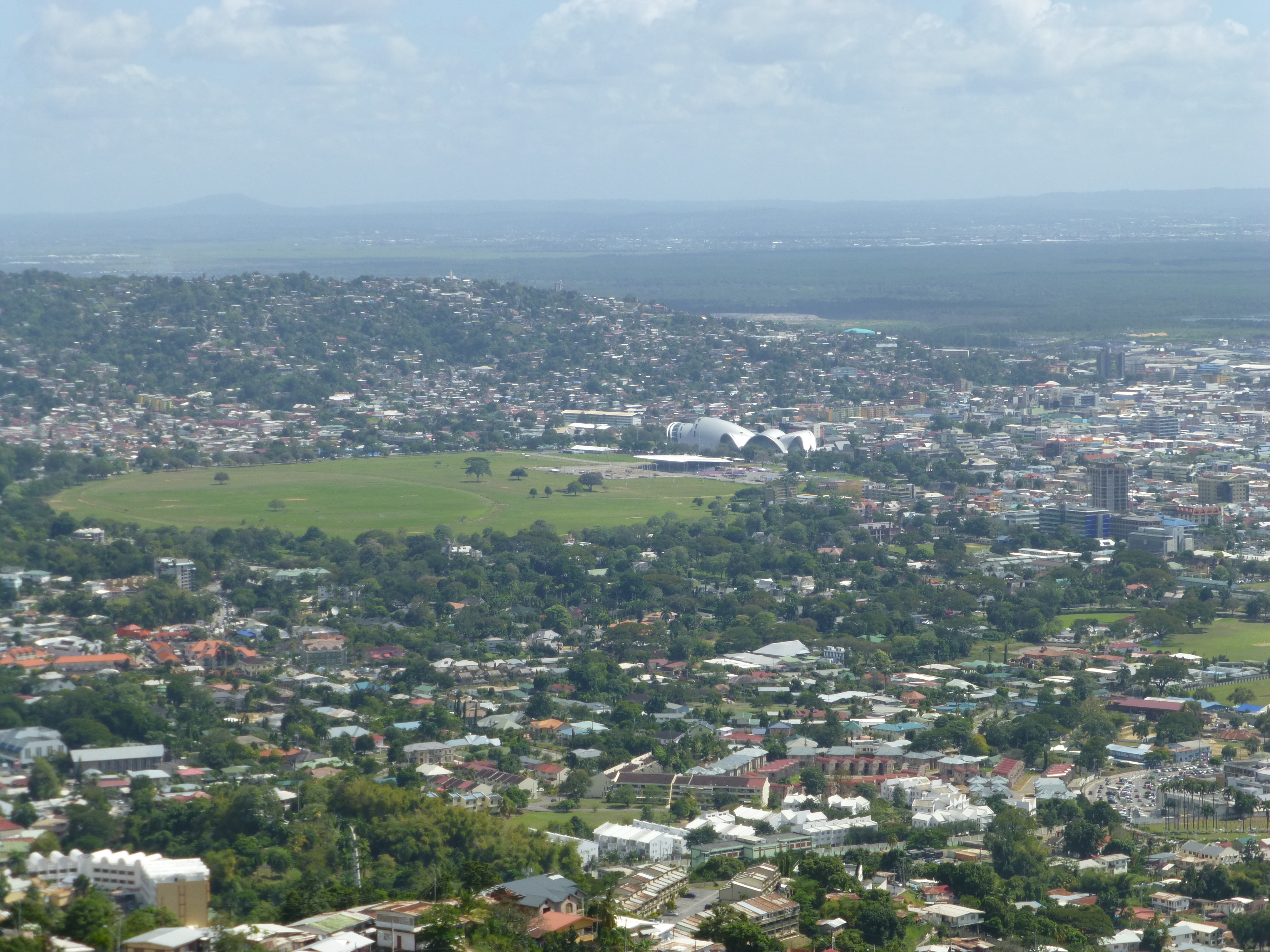|
Music Of Trinidad And Tobago
The music of Trinidad and Tobago is best known for its calypso music, soca music, chutney music, and steelpan. Calypso's internationally noted performances in the 1950s from native artists such as Lord Melody, Lord Kitchener and Mighty Sparrow. The art form was most popularised at that time by Harry Belafonte. Along with folk songs and African- and Indian-based classical forms, cross-cultural interactions have produced other indigenous forms of music including soca, rapso, parang, chutney, and other derivative and fusion styles. There are also local communities which practice and experiment with international classical and pop music, often fusing them with local steelpan instruments. MusicTT was established in 2014 to facilitate the business development and export activity of the music industry in Trinidad and Tobago. History The Cedula of Population of 1783 laid the foundation and growth of the population of Trinidad. The island's Spanish possessors contributed little towa ... [...More Info...] [...Related Items...] OR: [Wikipedia] [Google] [Baidu] |
French Antilles
The French West Indies or French Antilles (, ; ) are the parts of France located in the Antilles islands of the Caribbean: * The two Overseas department and region of France, overseas departments of: ** Guadeloupe, including the islands of Basse-Terre Island, Basse-Terre, Grande-Terre, Guadeloupe, Grande-Terre, Les Saintes, Marie-Galante, and La Désirade. ** Martinique * The two Overseas collectivity of France, overseas collectivities of: ** Collectivity of Saint Martin, Saint Martin, the northern half of the island with the same name, the southern half is Sint Maarten, a constituent country of the Kingdom of the Netherlands. ** Saint Barthélemy History Pierre Belain d'Esnambuc was a French trader and adventurer in the Caribbean, who established the first permanent French colony, Saint-Pierre, Martinique, Saint-Pierre, on the island of Martinique in 1635. Belain sailed to the Caribbean in 1625, hoping to establish a French settlement on the island of Basseterre, St. Christo ... [...More Info...] [...Related Items...] OR: [Wikipedia] [Google] [Baidu] |
Steel Band
The steelpan (also known as a pan or steel drum) is a musical instrument originating in Trinidad and Tobago from Afro–Trinidadians and Tobagonians, Afro-Trinidadians. Steelpan musicians are called pannists. In 1992, the steelpan was declared Trinidad and Tobago’s national instrument by Prime Minister Patrick Manning. This helped turn the steelpan into a source of national pride and cultural identity, recognized both locally and internationally. In 2023, the United Nations General Assembly declared August 11 as World Steelpan Day. The following year, the Parliament of Trinidad and Tobago officially recognised the steelpan as the country's national instrument. Description The modern pan is a Chromatic scale, chromatically pitch (music), pitched percussion instrument made from 200-litre drum, 200-litre industrial drums. ''Drum'' refers to the steel drum containers from which the pans are made; the steel drum is more correctly called a ''steel pan'' or ''pan'' as it falls int ... [...More Info...] [...Related Items...] OR: [Wikipedia] [Google] [Baidu] |
Trinidad & Tobago Carnival
The Trinidad and Tobago Carnival is an annual event held on the Monday and Tuesday before Ash Wednesday in Trinidad and Tobago. This event is well known for participants' colorful costumes and exuberant celebrations. There are numerous cultural events such as "band launch" fetes running in the lead up to the street parade on Carnival Monday and Tuesday. Traditionally, the festival is associated with calypso music, developed by Afro-Trinidadians in 17th century Trinidad; however, Soca music has begun to replace calypso as the more popular musical genre for Carnival. Costume (sometimes called " mas"), stick-fighting, limbo, and steelpan competitions are important components of the festival. Carnival, as it is celebrated in Trinidad and Tobago, has spread to many other Caribbean islands as well as several cities worldwide. These celebrations include Toronto's Caribana, Miami's Miami Carnival, Houston Carifest, London's Notting Hill Carnival, as well as New York City's Labor Day C ... [...More Info...] [...Related Items...] OR: [Wikipedia] [Google] [Baidu] |
Canboulay
Canboulay (from the French , meaning burnt cane) is a precursor to Trinidad and Tobago Carnival. The festival is also where calypso music has its roots. It was originally a harvest festival, at which drums, singing, dancing and chanting were an integral part. After Emancipation (1834), it developed into an outlet and a festival for former indentured laborers and freed slaves who were banned from participating in the masquerade carnival events – derived from European Christian traditions – of the colonial elite, and whose drums and religious observances were also outlawed in the late 19th century. Consequently, Canboulay has played an important role in the development of the music of Trinidad and Tobago, for it was the banning of percussion instruments in the 1880s that led to the surreptitious innovations that gave birth to steelpan The steelpan (also known as a pan or steel drum) is a musical instrument originating in Trinidad and Tobago from Afro–Trinidadians and Tobagon ... [...More Info...] [...Related Items...] OR: [Wikipedia] [Google] [Baidu] |
Carnival
Carnival (known as Shrovetide in certain localities) is a festive season that occurs at the close of the Christian pre-Lenten period, consisting of Quinquagesima or Shrove Sunday, Shrove Monday, and Shrove Tuesday or Mardi Gras. Carnival typically involves public party, celebrations, including events such as parades, public street party, street parties and other entertainments, combining some elements of a circus. Elaborate costumes and masks allow people to set aside their everyday individuality and experience a heightened sense of social unity.Bakhtin, Mikhail. 1984. ''Rabelais and his world''. Translated by H. Iswolsky. Bloomington: Indiana University Press. Original edition, ''Tvorchestvo Fransua Rable i narodnaia kul'tura srednevekov'ia i Renessansa'', 1965. Participants often indulge in excessive consumption of alcohol, meat, and other foods that will be forgone during upcoming Lent. Traditionally, butter, milk, and other animal products were not consumed "excessively", r ... [...More Info...] [...Related Items...] OR: [Wikipedia] [Google] [Baidu] |
Laventille
Laventille is a suburb of Port of Spain in Trinidad and Tobago. It is administered by the San Juan–Laventille Regional Corporation. Etymology The name ''Laventille'' hearkens back to colonial times, especially when the French dominated the cultural traditions of the island. One etymological derivation of the name is because the northeast trade winds come to this part of the island of Trinidad before reaching any other part of colonial Port of Spain – hence the metaphorical name ''"La Ventaille"'' (''"The Vent"''). Geographically, it is the source of Orographic precipitation for the capital city. Arts and culture Laventille is the place where steel pan was born, and the birthplace of innovative world-renowned tuners such as Rudolph Charles and Bertie Marshall. As the heart of the steelpan world, this is where pioneer Winston "Spree" Simon lived and created one of the century's new acoustical musical instruments. Laventille is the original home to Desperadoes Steel Orch ... [...More Info...] [...Related Items...] OR: [Wikipedia] [Google] [Baidu] |
Carenage
Carenage is a town in Trinidad and Tobago. It is located on northwestern Trinidad Trinidad is the larger, more populous island of the Republic of Trinidad and Tobago, the country. The island lies off the northeastern coast of Venezuela and sits on the continental shelf of South America. It is the southernmost island in ..., and is administered by the Diego Martin Regional Corporation. Located close to Chaguaramas, it is more of a residential area than a commercial or industrial locale. The name is derived from the practice of careening (i.e., beaching, "carénage" in French) sailing vessels for maintenance, which had been done in the area for many years. References Populated places in Trinidad and Tobago {{trinidad-geo-stub ... [...More Info...] [...Related Items...] OR: [Wikipedia] [Google] [Baidu] |
Paramin
Paramin is a village located on one of the highest points of western area of the Northern Range in Trinidad, Trinidad and Tobago, which forms part of the Maraval area. It is a sprawling, steep and mountainous village whose residents have traditionally been farmers, producing herbs like chives, thyme and parsley, as well as vegetables like tomatoes and yams. Population Many of the original residents of the area are descendants of the Creole peoples#Caribbean, French Creole migrants to the island following the Cedula of Population (1783) and the surnames reflect this heritage: Constantine, Boisson, Fournillier (Fournier), Isidore, Laurent (Lawrence), Pascal, Romany, etc. Following the Cedula of Population, Paramin was peopled by immigrants from Martinique, Guadeloupe, Grenada (La Grenade), Dominica (La Dominique), St. Lucia (Ste. Lucie), etc. Paramin was later also populated by Cocoa Panyols from Venezuela in South America who aided in establishing the cocoa industry. The ... [...More Info...] [...Related Items...] OR: [Wikipedia] [Google] [Baidu] |
Blanchisseuse
Blanchisseuse () is a village in Trinidad and Tobago. It is located about midway along the north coast of Trinidad on the northern slope of the Northern Range, about 24 km north of Arima. The village was settled by the French people, French following the ''Cedula of Population'' in 1783. When Captain Frederick Mallet was charting and surveying the island of Trinidad following its capitulation to the Kingdom of Great Britain, British in 1797, he was told that the village had no name. Observing the women washing clothes in the river, he simply wrote on his survey chart: "Ladies River". Later, the settlers called the place after the washerwoman, washerwomen the surveyor had seen, ''blanchisseuse'' being the French language, French for "washerwoman". The difficult terrain meant there was little development or expansion, and no roads. The settlement was a clearing with thick forests and Northern Range, mountains behind and the sea in front. The village is accessible from Po ... [...More Info...] [...Related Items...] OR: [Wikipedia] [Google] [Baidu] |
Dominica
Dominica, officially the Commonwealth of Dominica, is an island country in the Caribbean. It is part of the Windward Islands chain in the Lesser Antilles archipelago in the Caribbean Sea. The capital, Roseau, is located on the western side of the island. Dominica's closest neighbours are two Special member state territories and the European Union, constituent territories of the European Union, both overseas departments of France: Guadeloupe to the northwest and Martinique to the south-southeast. Dominica comprises a land area of , and the highest point is Morne Diablotins, at in elevation. The population was 71,293 at the 2011 census. The island was settled by the Arawak arriving from South America in the fifth century. The Kalinago displaced the Arawak by the 15th century. Christopher Columbus is said to have passed the island on Sunday, 3 November 1493. It was later colonised by Europeans, predominantly by the French from the 1690s to 1763. The French trafficked slaves from W ... [...More Info...] [...Related Items...] OR: [Wikipedia] [Google] [Baidu] |





